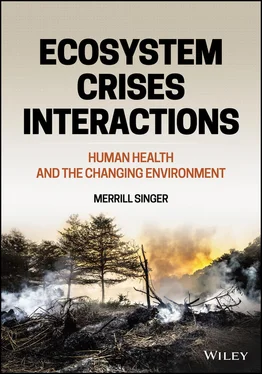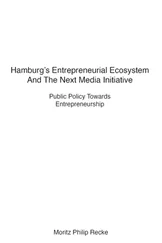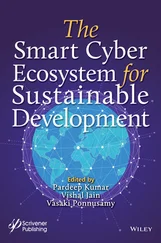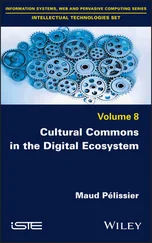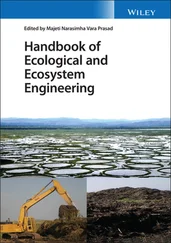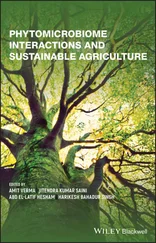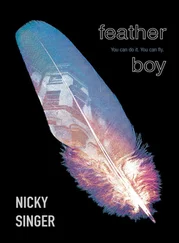69 Mora, C., Tittensor, D., Adl, S., Simpson, A. & Worm, B. (2011). How many species are there on earth and in the ocean? PLoS Biology 9(8): e1001127.
70 Moran, J. (2012). Weather Studies: Introduction to Atmospheric Science, 5 edn. Boston, MA: American Meteorological Society.
71 Nagajan, R. (2016). The myth of India’s population explosion. Times of India. https://blogs.timesofindia.indiatimes.com/staying‐alive/the‐myth‐of‐indias‐population‐explosion/.
72 New Phytologist Foundation. (n.d.). Sir Arthur George Tansley, 1871–1955. https://www.newphytologist.org/trust/tansley/about.
73 Nogués‐Bravo, D., Rodríguez‐Sánchez, F., Orsini, L., de Boer, E., Jansson, R., Morlon, H. et al. (2018). Cracking the code of biodiversity responses to past climate change. Trends in Ecology and Evolution 33(10): 765–776.
74 Noyes, P. & Lema, S. (2015). Forecasting the impacts of chemical pollution and climate change interactions on the health of wildlife. Current Zoology 61(4): 669–689.
75 Oftedal, O., Alt, G., Widdowson, E. & Jakubasz, M. (1993). Nutrition and growth of suckling black bears (Ursus americanus) during their mothers' winter fast. British Journal of Nutrition 70: 5–79.
76 Oliver, D. (1989). Food and food getting: the islands. In: D. Oliver (Ed.), Oceania: The Native Cultures of the Pacific Islands, vol 1. Honolulu, HI: University of Hawaii Press.
77 Paine, R. (1966). Food web complexity and species diversity. American Naturalist 100(910): 65–75.
78 Paine, R. (1969). A note on trophic complexity and community stability. American Naturalist 103(929): 91–93.
79 Paine, R. (2005). Cross environment talk in ecology: fact or fantasy? Marine Ecology Progress Series 304: 280–282.
80 Parks, D., Rinke, C., Chuvochina, M., Pierre‐Alain Chaumeil, P.‐A. & Woodcroft, B. (2017). Recovery of nearly 8000 metagenome‐assembled genomes substantially expands the tree of life. Nature Microbiology 2: 1533–1542.
81 Pedersen, M. (2011). Not quite shamans: spirit worlds and political lives in Northern Mongolia. Ithaca, NY: Cornell University Press.
82 Peterson, G., Allen, C. & Hollimh, C. (1998). Ecological resilience, biodiversity, and scale. Ecosystems 1: 6–18.
83 Pike, K. (1967). Language in Relation to a Unified Theory of the Structure of Human Behavior, 2 edn. The Hague: Mouton.
84 Primack, R. (2014). Walden Warming: Climate Change comes to Thoreau's Woods. Chicago, IL: University of Chicago Press.
85 Pulmonary Fibrosis News. (2016). AD‐114 for pulmonary fibrosis. https://pulmonaryfibrosisnews.com/ad‐114‐for‐pulmonary‐fibrosis/.
86 Rainer, T. & West, C. (2016). Planting in a Post‐Wild World: Designing Plant Communities for Resilient Landscapes. Portland, OR: Timberwood Press.
87 Reid, W., Laird, S., Meyer, C., Gámez, R., Sittenfeld, A., Janzen, D., et al. (1993). Biodiversity Prospecting: Using Resources for Sustainable Development. Washington, D.C.: World Resource Institute.
88 Ross, W. & Forbes, F. (Trans.). (1967). Theophrastus, Metaphysics. Hildesheim: Georg Olms.
89 Scheffer, M., Carpenter, S., Foley, J., Folke, C. & Walker, B. (2001). Catastrophic shifts in ecosystems. Nature 413: 591–596.
90 Schulman, J. (2017). A timeline of every ridiculous thing trump has said about climate change. ABC. https://gma.yahoo.com/timeline‐every‐ridiculous‐thing‐trump‐131002181.html.
91 Schulze, E.‐D., Beck, E. & Muller‐Hohenstein, K. (2002). Plant Ecology. New York: Springer.
92 Sears, P. (1964). Ecology: a subversive subject. BioScience 14(7): 11–13.
93 Silvano, R. & Begossi, A. (2016). From ethnobiology to ecotoxicology: Fishers’ knowledge on trophic levels as indicator of bioaccumulation in tropical marine and freshwater fishes. Ecosystems 19: 1310–1324.
94 Stager, J., Wiltse, B., Hubeny, J., Yankowsky, E., Nardelli, D. & Primack, R. (2018). Climate variability and cultural eutrophication at Walden Pond (Massachusetts, USA) during the last 1800 years. PLoS ONE 13(4): e0191755.
95 Stutz, B. (2009). Finding new species: the golden age of discovery. YaleEnvironment360. https://e360.yale.edu/features/finding_new_species_the_golden_age_of_discovery.
96 Symstad, A., Tilman, D., Willson, J. & Knops, J. (1998). Species loss and ecosystem functioning: effects of species identity and community composition. Oikos 81(2): 389–397.
97 Theobald, D. (2010). A formal test of the theory of universal common ancestry. Nature 465: 219–222.
98 Thoreau, H. (2016). Walden Pond; Or, Life in the Woods. Eastford, CT: Martino Fine.
99 Turak, E., Brazill‐Boasta, J., Cooney, T., Drielsma, M., DelaCruza, J., Dunkerley, G. et al. (2017). Using the essential biodiversity variables framework to measure biodiversity change at national scale. Biological Conservation 213(Part B): 264–271.
100 U.S. Geological Survey. (2016). Groundwater flow and the water cycle. https://water.usgs.gov/edu/watercyclegwdischarge.html.
101 Van Der Ploeg, J. & Van Weerd, M. (2010). Agta bird names: an ethno‐ornithological survey in the Northern Sierra Madre Natural Park, Philippines. Forktail 26: 127–131.
102 Vayda, A. & Rappaport, R. (1968). Ecology: cultural and noncultural. In: J. Clifton (Ed.), Introduction to Cultural Anthropology, pp. 476–497. Boston, MA: Houghton Mifflin.
103 Viveiros de Castro, E. (2004). Exchanging perspectives: the transformation of objects into subjects in Amerindian ontologies. Common Knowledge 10: 463–484.
104 Wardle, D., Bardgett, R., Callaway, R. & Van der Putten, W. (2011). Terrestrial ecosystem responses to species gains and losses. Science 332(6035): 1273–1277.
105 Wax, M. (1972). Tenting with Malinowski. American Sociological Review 37(1): 1–13.
106 Webster, J., Brook, G., Railsback, B., Cheng, H., Edwards, L., Alexandere, C. & Reeder. P. (2007). Stalagmite evidence from Belize indicating significant droughts at the time of Preclassic Abandonment, the Maya Hiatus, and the Classic Maya collapse. Palaeogeography, Palaeoclimatology, Palaeoecology 250: 1–17.
107 Wetzel, F., Bingham, H., Groom, Q., Haasee, P., Kõljalgg, U., Kuhlmann, M. et al. (2017). Unlocking biodiversity data: prioritization and filling the gaps in biodiversity observation data in Europe. Biological Convention 221: 78–85.
108 Wheeler, Q. & Meier, R. (2000). Species Concepts and Phylogenetic Theory: A Debate. New York: Columbia University Press.
109 Vitousek, P., Mooney, H., Jane Lubchenco, J. & Melillo, J. (1997). Human domination of Earth's ecosystems. Science 277(5325): 494–499.
110 Zhang, X., Lei, Y., Zhihai, M., Kneeshaw, D. & Peng, C. (2014). Insect induced tree mortality of boreal forests in eastern Canada under a changing climate. Ecology and Evolution 4(12): 2384–2394.
111 Zimmermann, K. (2013). What is a jet stream? LiveScience. https://www.livescience.com/27825‐jet‐stream.html.
112 Zorgdrager, N. (2008). Linnaeus as ethnographer of Sami culture. TijdSchrift voor Skandinavistiek 29: 45–76.
Конец ознакомительного фрагмента.
Текст предоставлен ООО «ЛитРес».
Прочитайте эту книгу целиком, купив полную легальную версию на ЛитРес.
Безопасно оплатить книгу можно банковской картой Visa, MasterCard, Maestro, со счета мобильного телефона, с платежного терминала, в салоне МТС или Связной, через PayPal, WebMoney, Яндекс.Деньги, QIWI Кошелек, бонусными картами или другим удобным Вам способом.
